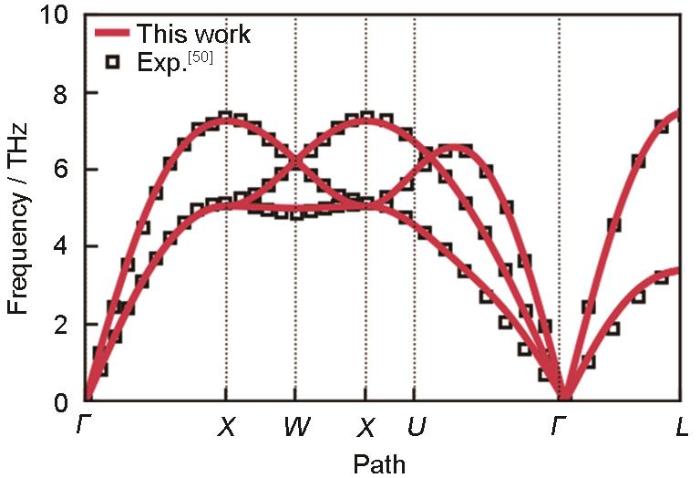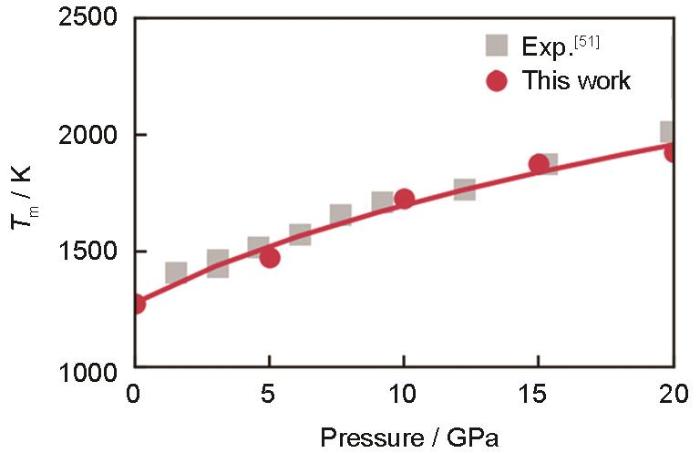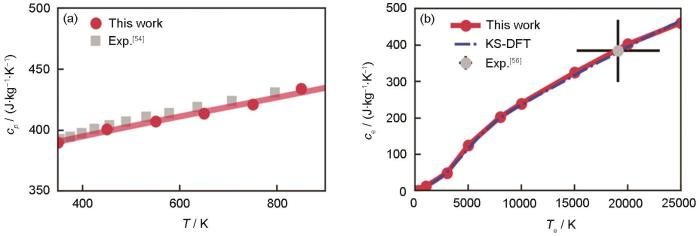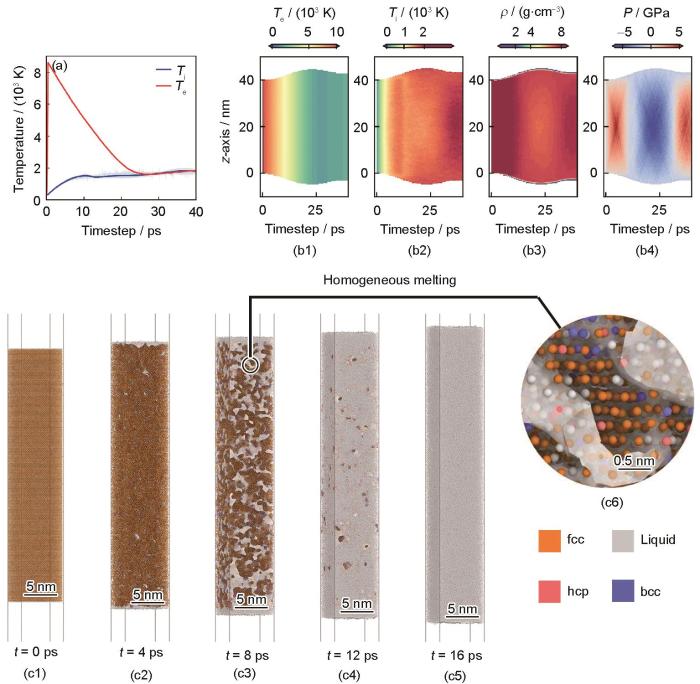在实验上,由于超快激光作用的瞬态特性,理解其动力学过程离不开超快时间分辨诊断技术。在过去的几十年里,人们陆续发展了光学泵浦探测实验[5,6]、超快电子衍射(ultrafast electron diffraction,UED)[7~10]、X射线近边吸收光谱(X-ray absorption near-edge spectra,XANES)[11,12]和时间分辨太赫兹电导率测量[13]等多种诊断方法来理解材料在超快激光作用下的电子、晶格结构响应。Cu、Au等贵金属化学性质稳定,且在工业上应用广泛,具有相对其他金属较弱的电声耦合系数,导致晶格加热的时间尺度更长,更有利于观察和研究激光激发产生的非平衡结构演化动力学[14~16]。研究者[12,17,18]通过测量X射线近边吸收谱的含时演化,观察到超高激光通量下Cu在皮秒乃至亚皮秒时间内就发生了晶格长程有序性的消失。Mo等[8]则通过时间分辨的超快电子衍射实验,观察到随激光通量增加Au薄膜熔化时间尺度表现出巨大的差异,跨越纳秒到皮秒量级。需要注意的是,时间分辨的XANES和UED实验提供的主要是电子结构或者长程统计的晶格结构,且空间分辨率有限,无法提供有效的微观结构信息,这使得激光诱导熔化动力学的微观机理依然不明确。
因此,从原子尺度出发的分子动力学(molecular dynamics,MD)模拟一直是理解激光-物质相互作用的重要研究手段。在这方面,人们将MD与双温模型(two-temperature model,TTM)耦合,将电子处理为连续介质,原子运动采用MD描述,可以有效研究金属在超快激光作用下的微观动力学。在具体实验和计算过程中,考虑到激发电子的弹道输运自由程通常在百纳米范围,通常采用厚度在几十纳米的金属薄膜作为实验和计算模拟的具体对象,以保证激光能量的均匀沉积,从而可以将整个研究体系当作温度均匀分布的体系处理,更利于实验观察和理论结果的解读与分析[16]。传统方法通常采用经典分子动力学方法,利用嵌入原子势(embedded-atom-method,EAM)考虑原子间相互作用,且通常忽略激发电子的贡献。例如,Lin和Zhigilei[19]使用基于EAM的TTM-MD方法,实现了20 nm厚Au薄膜的激光过程模拟,深入分析了均匀熔化和非均匀熔化2种熔化行为的微观机理。Molina和White[20]采用基于EAM的TTM-MD模拟还原了UED实验的衍射峰下降行为,分析了激光过程中可能的能量损失路径。这些工作有效弥补了实验分辨率的不足,为理解超快熔化动力学过程提供了基于原子尺度的微观图像。
但是,MD的准确性严重依赖于原子间相互作用势能面(potential energy surface,PES)。作为典型的非线性高维函数,PES难以直接被唯象模型所准确建模,尤其是激光过程涉及到从凝聚态到高温高压状态、甚至是理想等离子体的剧烈物态转变,且其中电子激发带来的影响至关重要。即使是对金属体系建模效果较好的EAM,也很难兼顾宽热力学区间且多相共存的准确描述[21~24],特别是在绝大多数情况下,无法考虑随时间演化的电子激发的贡献。如近期Arefev等[25]采用高度优化的EAM,也无法通过任何具有物理意义的参数调整来复现UED实验所测量的Au薄膜熔化动力学。经验势的不足,意味着更完整精确的PES描述必须从其构建的基本原理,也就是量子力学出发。以密度泛函理论(density function theory,DFT)为代表的从头算分子动力学(ab initio molecular dynamics,AIMD)方法,通过求解Kohn-Sham (KS)方程可以获得高精度的原子间相互作用力。但由于第一性原理计算方法的计算复杂度与体系自由度的立方成正比,使其只能处理包含数百原子的小体系,无法满足直接模拟超快激光过程中结构演化、多相共存的规模需要。这种效率-精度两难的困境,制约了原子建模方法在理解激光-物质相互作用过程的应用,也很难为其提供更为深入的物理图像。
当前,随着深度学习技术广泛应用到原子建模领域,大量研究[26~35]证明了基于神经网络形式的势能面构建可以在有效保持第一性原理精度的同时保证线性的计算标度,这为建模宽热力学区间复杂高维的势能面提供了新的技术途径。近期Zeng等[36]发展了双温模型耦合深度势能分子动力学(two-temperature-model coupled deep potential molecular dynamics,TTM-DPMD)方法,将神经网络形式的PES与TTM-MD方法结合,实现了超快激光作用下热过程和非热过程的统一理论描述,为开展大尺度第一性原理精度超快激光驱动物质结构演化过程的直接模拟提供了有效手段。本工作以Cu为研究对象,验证了神经网络PES对激光与物质相互作用过程中产生的高温高压状态的描述能力,并结合所发展的TTM-DPMD方法,在量子精度下探讨了Cu薄膜在超快激光下的结构响应动力学。
1 研究方法
1.1 TTM-DPMD方法
式中,M为粒子质量,n为粒子数密度,kB为Boltzmann常数。
式中,t'为不同于t的离子运动时刻;δ表示Dirac函数,若t' = t,函数为0,若t' ≠ t,函数为无穷大。
S(r, t)表示激光源,在本工作中,激光垂直于薄膜平面(x-y平面)入射,其能量沉积沿着z方向根据光学穿透深度发生指数衰减。在时域上,激光是一个Gaussian分布,其表达式为[40]:
式中,Fabs为材料实际吸收的激光通量,σ为含时Gaussian分布的标准差,Lp为光学穿透深度,Lz 为z方向的光学穿透深度,d为样品厚度,t0为到达激光脉冲最大值的时间。
在上述基础上,本工作基于LAMMPS软件中修改过的EXTRA-FIX模块开展TTM-DPMD模拟[36]。在TTM-DPMD中,电声耦合系数选为0.9 × 1017 W/(m3·K),激光为Gaussian形脉冲,激光脉冲脉宽为130 fs。为了描述温度梯度带来的热输运,κe采用Drude模型来描述:
式中,vF是Fermi速率,τe(Te, Ti)是由电子-电子散射和电子-声子散射时间定义的电子散射总时间,即:
式中,τe-e为电子散射时间,τe-ph为电子-声子散射时间。在模拟时,
1.2 深度势能(DP)模型构建
在TTM-DPMD方法中,可靠的深度势(DP势)是进行大尺度第一性原理精度超快激光驱动物质结构演化过程的直接模拟的保证。在深度势能(deep potential,DP)方法中,深度神经网络被用于建立描述子到单原子能量的高维映射关系,以描述从凝聚态到高温高压物质区间的复杂势能面。在有限温度密度泛函理论的框架下,在DP模型中额外引入了能量对电子温度的显式依赖,以包含电子熵对总能量的贡献,从而更好地建模金属体系。电子温度依赖的深度势能 (electron-temperature-dependent DP,ETD-DP)模型的数学表述如下[36]:
式中,ri 表示第i个原子的坐标;
为了有效地探索不同温度、压力下的fcc和液相结构,本工作进一步在初始训练集的基础上,构建4个初始随机数种子不同的DP模型,以模型偏差为判据,结合同步学习方案对激光过程涉及到的高温、高压区间进行构型采样。如表1所示,考虑到激光过程涉及到晶格的等容、等压加热过程和熔化动力学,本工作采用等温等压系综(NPT,其中P代表系统压强)和NVT对晶格温度为300~3000 K,压强为0~30 GPa的热力学空间进行充分探索,总共采样了3417个fcc构型和2160个液相构型。
表1 不同热力学条件下Cu深度势能(DP)模型的构型探索
Table 1
| Iter. | Lattice structure | Time / ps | Ensemble type | Temperature / K | Pressure / GPa | Sampled configuration |
|---|---|---|---|---|---|---|
| 0 | fcc | 0.5 | NPT | 300 | 0 | 0 |
| 1 | fcc | 1 | NPT | 300 | 0 | 0 |
| 2 | fcc | 2 | NPT | 300 | 0 | 0 |
| 3 | fcc | 4 | NPT | 300 | 0 | 0 |
| 4 | fcc | 8 | NPT | 300 | 0 | 0 |
| 5 | fcc | 16 | NPT | 300 | 0 | 5 |
| 6 | fcc | 4 | NVT | 200, 400 | 7 | |
| 7 | fcc | 16 | NVT | 200, 400 | 1 | |
| 8 | fcc | 2 | NVT | 500 | 60 | |
| 9 | fcc | 4 | NVT | 500 | 5 | |
| 10 | fcc | 16 | NVT | 500 | 10 | |
| 11 | fcc | 2 | NVT | 800 | 13 | |
| 12 | fcc | 4 | NVT | 800 | 9 | |
| 13 | fcc | 16 | NVT | 800 | 60 | |
| 14 | fcc | 2 | NVT | 1000, 1200, 1500 | 60 | |
| 15 | fcc | 4 | NVT | 1000, 1200, 1500 | 60 | |
| 16 | fcc | 16 | NVT | 1000, 1200, 1500 | 60 | |
| 17 | fcc | 0.5 | NPT | 300 | 0 | 21 |
| 18 | fcc | 1 | NPT | 300 | 0 | 46 |
| 19 | fcc | 2 | NPT | 300 | 0 | 60 |
| 20 | fcc | 4 | NPT | 300 | 0 | 60 |
| 21 | fcc | 8 | NPT | 300 | 0 | 60 |
| 22 | fcc | 16 | NVT | 300 | 60 | |
| 23 | fcc | 4 | NVT | 200, 400 | 60 | |
| 24 | fcc | 16 | NVT | 200, 400 | 60 | |
| 25 | fcc | 2 | NVT | 500 | 60 | |
| 26 | fcc | 4 | NVT | 500 | 60 | |
| 27 | fcc | 16 | NVT | 500 | 60 | |
| 28 | fcc | 2 | NVT | 800 | 60 | |
| 29 | fcc | 4 | NVT | 800 | 60 | |
| 30 | fcc | 16 | NVT | 800 | 60 | |
| 31 | fcc | 2 | NVT | 1000, 1200 | 60 | |
| 32 | fcc | 4 | NVT | 1000, 1200 | 60 | |
| 33 | fcc | 8 | NVT | 1000, 1200 | 60 | |
| 34 | fcc, liquid | 2 | NVT | 1500, 2000, 2500 | 60, 60 | |
| 35 | fcc, liquid | 4 | NVT | 1500, 2000, 2500 | 60, 60 | |
| 36 | fcc, liquid | 8 | NVT | 1500, 2000, 2500 | 60, 60 | |
| 37 | Liquid | 2 | NVT | 3000 | 60 |
(续表)
采样的构型通过第一性原理方法标定总能量、受力和Virial张量,自洽场迭代通过VASP软件实现[43],交换关联泛函选取Perdew-Burke-Ernzerhof (PBE)近似[45],赝势形式为投影缀加平面波(projector augmented wave,PAW),包含11个价电子(电子构型为3d104s1)。为了保证能量精度收敛到1 eV/atom,倒空间Brillouin区采样密度为2.5 nm-1,动能截断为700 eV。势函数训练过程中,嵌入网格包含3层隐藏全连接层,每层神经元数目分别为25、50和100个,以端到端地提取局域原子环境的特征。拟合网络也包含3层隐藏层,每层用了240个神经元节点,同样为全连接网络。将能量、力和Virial项的训练权重初始时刻分别设置为0.2、1000和0.2,从而优先拟合受力,加快训练过程的收敛,在训练后期权重参数均设置为1,3者有着相同的权重,同时保证3者的精度。总共训练步数设置为100 × 104步,将神经网络模型的权值冻结后,就获得Cu在宽热力学区间的神经网络势函数。
| Iter | Lattice structure | Time / ps | Ensemble type | Temperature / K | Pressure / GPa | Sampled configuration |
|---|---|---|---|---|---|---|
| 38 | Liquid | 4 | NVT | 3000 | 60 | |
| 39 | Liquid | 8 | NVT | 3000 | 60 | |
| 40 | fcc | 2 | NPT | 300, 500, 800, 1000, 1200, 1500 | 0, 1, 5, 10 | 600 |
| 41 | fcc | 4 | NPT | 300, 500, 800, 1000, 1200, 1500 | 0, 1, 5, 10 | 600 |
| 42 | fcc | 8 | NPT | 300, 500, 800, 1000, 1200, 1500 | 0, 1, 5, 10 | 720 |
| 43 | Liquid | 2 | NPT | 1500, 2000, 2500, 3000 | 0, 1, 5, 10 | 600 |
| 44 | Liquid | 4 | NPT | 1500, 2000, 2500, 3000 | 0, 1, 5, 10 | 600 |
| 45 | Liquid | 8 | NPT | 1500, 2000, 2500, 3000 | 0, 1, 5, 10 | 600 |
2 研究结果与讨论
2.1 DP模型能量、力及Virial预测精度
Cu的DP模型在数据集上的能量、受力、Virial预测精度如图1所示。其中,能量的均方根偏差(root mean square error,RMSE)为2.21 meV/atom,受力的RMSE为3.2 eV/nm,Virial张量的RMSE为0.27 eV。整体来看,与DFT计算相比,Cu的DP模型已经具有很高的精度。
图1
图1
Cu的DP模型预测值和密度泛函理论(DFT)计算的能量、受力和Virial张量的对比
Fig.1
Comparisions of DP model predicted energy from DP model (EDP),force (fDP), and virial tensor (VDP) of Cu with the energy (EDFT), force (fDFT), and virial tensor (VDFT) on the training set calculated by density functional theory (DFT)
(a) EDP-EDFT (b) fDP-fDFT (c) VDP-VDFT
2.2 Cu的基本热力学性质
在完成DP模型在数据集上的精度验证后,需要对DP模型描述激光过程的可靠性开展更为细致的验证。超快激光诱导的熔化动力学研究,离不开对Cu热物理性质的准确评估。首先结合深度势能分子动力学(DPMD),评估DP模型对Cu初态的描述能力,DPMD模拟均基于LAMMPS开源软件包[47]实现。本工作构建了包含4000个原子的fcc晶格,在NPT系综下(压力P = 105 Pa,温度T = 300 K)进行充分弛豫,获得其a0为0.3655 nm,与实验结果[48]相符合(见表2),相对误差为1.12%。在平衡晶格常数的基础上,采用ALAMODE软件包[49]计算了声子谱,其与晶格的弹性常数、声速等密切相关。对2 × 2 × 2的fcc超胞计算原子间受力,通过有限位移法获得二阶力常数,其中施加的位移扰动为0.001 nm。计算得到的声子色散曲线如图2所示,与Nilsson和Rolandson[50]的实验测量结果对比,DP模型预测的声子谱在各个倒空间路径上均表现出良好的一致性,这说明DP模型可以准确描述Cu的晶格动力学。
表2 使用DP模型得到的Cu的晶格常数(a0)、熔点(Tm)、相变潜热(ΔHm)、熔化阈值(εm)及其与实验值[48,51,53~56]的对比
Table 2
图2
激光熔化过程离不开对熔点(Tm)、相变潜热(ΔHm)、焓变等热物理量的准确评估。在评估过程中构建了包含32000个原子的fcc晶格,通过两相法构建固/液界面以驱动熔化。在NPT下,两相法可以有效计算不同压强条件下的熔点,如图3所示,DPMD计算的熔化曲线与Japel等[51]的实验测量相符合。在常压下(P = 105 Pa),Tm为(1275 ± 25) K,与实验值的偏差为0.39%,在误差范围内(表2)。随着压强增加到20 GPa,Cu的Tm单调上升为1894 K。采用Simon-Glatzel方程拟合Cu的熔化曲线[52],具体表达式为Tm = T0(1 + P / a) b,得到拟合参数T0为1275 K,a为6.23 GPa,b为0.32。
图3
图3
不同压强条件下Cu熔点的DP模型结果与实验结果[51]对比
Fig.3
DP model results and experimental results of Cu melting point under different pressure conditions (The red dots are the melting points under different pressure conditions calculated using DP, the red curve is the melting curve fitted using Simon-Glatzel equation[52], and the silver squares are the experimental result[51])
ΔHm表示体系从固体转变到液相过程中所吸收的热量,是体系熔化过程中一个重要的热力学状态参量。通过计算常压Tm处固/液两相的焓(Hm)的差,即可得到ΔHm。Hm可以通过体系的总能量(Fm)及在Tm附近的能量对温度的梯度(ΔFm / ΔTm)计算得到:
图4
图4
Cu的晶格比热容(cp )和电子比热容(ce)
Fig.4
Lattice heat capacity (cp ) and electron heat capacity (ce) of Cu
(a) cp of Cu varied with ionic temperature (T) (The red dots are the result obtained using the DP potential, and the silver squares are the experimental result[54])
(b) ce of Cu varied with electron temperature (Te) (The red dots are the result of this work, the dashed blue lines are Smirnov's KS-DFT result[55] and the silver squares are the experimental result[56])
2.3 Cu熔化阈值
综合上述结果可见,本工作构造的DP模型可以有效描述Cu在激光加热到熔化过程中的热物理性质。在此基础上可以估算出激光熔化阈值(εm),即给定厚度的Cu薄膜完成熔化所需要的激光能量。εm的表达式为:
式中,等式右侧第一项为晶格系统需要的能量,第二项为电子系统需要的能量。cl(T)为晶格热容,使用图4a中的结果,ce使用图4b中的结果,ΔHm和Tm采用表2中的结果,从而估计Cu的εm为(658.71 ± 49.11) kJ/kg (在40 nm厚的Cu薄膜中1 mJ/cm2 = 28.89 kJ/kg,因此εm也可以写为(22.8 ± 1.7) mJ/cm2)。其中,电子系统达到熔点所需能量为(8.2 ± 0.9) kJ/kg,晶格系统加热达到熔点所需能量为(419.4 ± 37.0) kJ/kg,熔化相变潜热所需能量为(232.3 ± 11.2) kJ/kg。与使用实验值计算得到的Cu的εm为661.3 kJ/kg[51,53~56]的误差仅为0.40% (表2),其高度一致性为后续结合TTM-DPMD开展超快激光加热过程的熔化动力学研究提供了可靠保障。
2.4 低激光通量下的非均匀熔化动力学及其机理分析
首先探讨激光通量为18 mJ/cm2 (对应的能量密度为520 kJ/kg)作用下的Cu薄膜熔化动力学。在激光激发的亚皮秒时间尺度内,薄膜中的电子在超快激光激发后快速热化,由于Cu薄膜中激发态电子的平均自由程超过40 nm,弹道电子到达薄膜表面迅速反射,使得激光能量在40 nm厚的Cu薄膜内均匀沉积[14,55~57],形成空间上均匀的双温状态,电子温度为6821 K,而晶格温度为300 K,如图5a所示,在接下来的10 ps内,电声耦合导致的非绝热能量交换使得冷晶格迅速升温,相应的加热速率高达113 K/ps。仅20 ps后,Cu薄膜达到电子-离子间的热平衡,平衡温度为1386 K,约是常压下Tm的1.1倍。由于这种极高的加热速率远大于热膨胀的时间尺度,在惯性约束下薄膜内部升温并积累热动压,体系沿着等容线演化,在t = 5 ps时,薄膜内部的压强为5.3 GPa,温度为865 K。随着压强从自由表面开始释放,薄膜发生膨胀的同时在内部逐步积累拉应力,在t = 10 ps时,形成5.2 GPa的负压。如图5b1~b4所示,这种应力波在薄膜内的传播与反射,伴随着压强、密度和温度的周期性震荡,并由于能量耗散[19],震荡强度会逐渐衰减,表示能量逐步从晶格的集体运动传递给热动能。
图5
图5
18 mJ/cm2激光通量下Cu薄膜的演化动力学过程
Fig.5
Evolutionary dynamics of Cu thin films at the laser flux of 18 mJ/cm2
(a) evolution of ion temperature (Ti) and (Te) over time
(b1-b4) evolutions of Te (b1), Ti (b2), density (ρ) (b3), and pressure (P) (b4) in different regions in the z direction of the Cu film with time
(c1-c6) atomic scale structural evolutions at time t = 0 ps (c1), 50 ps (c2), 100 ps (c3, c6), 150 ps (c4), and 200 ps (c5) (Fig.5c6 is the locally enlarged view of Fig.5c3, and polyhedral surface meshes (white interface) around fcc-type (brass) and liquid-type (gray) particles are constructed to highlight the heterogeneous phase transition)
从原子尺度出发,可观察到激光的结构演化表现出显著的各向异性。如图5c1~c6所示,在t = 50 ps时,晶格温度接近熔点(1300 K),此时,薄膜表面由于自由能较低而先发生熔化,形成长程无序的液相结构;而薄膜内部虽然处于轻微的过热状态,但是尚不足以克服相变势垒,依然表现出热扰动的fcc晶格。这使得在薄膜表面区域形成了明显的固/液界面。固/液界面(熔化前沿)的形成显著降低了晶格发生固/液相变的势垒,从而促进内部区域吸收相变潜热并发生结构失稳,形成液相结构,在时空上表现为熔化前沿向内传播。该熔化前沿以50.6 m/s的速率向内传播,显著低于Cu的声速,驱动40 nm厚的薄膜完全熔化需要约400 ps,如此缓慢的熔化时间,与Lin和Zhigilei[19]的非均匀熔化图像相符合,也与Mo等[8]实验观察到的数百皮秒甚至纳秒时间尺度的熔化动力学相符。但在该激光通量(18 mJ/cm2)的TTM-DPMD模拟中,熔化前沿在200 ps左右已基本稳定,不再向内移动。其原因是该薄膜内超过熔点的热动能已完全转化为熔化潜热,薄膜温度下降到两相共存点,形成了固/液共存的不完全熔化状态。其本质是该激光通量的能量低于完全熔化阈值((22.8 ± 1.7) mJ/cm2),还不足以使薄膜发生完全熔化,这与上一节的热物理性质计算相互印证。
2.5 高激光通量下的均匀熔化动力学及其机理分析
进一步,将激光通量增加到30 mJ/cm2 (对应的能量密度为870 kJ/kg),此时激光通量已经远高于熔化阈值。如图6a所示,在t = 1 ps时,激光能量的沉积产生了更加极端的双温状态,其中电子温度为8500 K,对应的电声耦合系统在28 ps后达到电子-离子之间的热平衡,加热速率约为154 K/ps,比低通量下的加热速率提高了36%。不同于低通量下的现象,由于高通量下更多的激光能量转换为薄膜内的热动能,晶格在t = 10 ps达到最高温度(1607 K,约1.25Tm),已接近晶格热稳定性极限[46],薄膜处于极端过热状态。但在接下来的2 ps内,离子温度显著下降约139 K,这表明薄膜内的热动能转换为相变潜热,意味着晶格在数个皮秒内就发生了熔化,这与低通量的结果截然不同。Cu薄膜的热力学状态时空演化进一步验证了这种超快熔化过程,如图6b1~b4所示,在12 ps以后,薄膜的温度、密度都发生了均匀而剧烈的下降,密度从8.64 g/cm3下降到7.52 g/cm3,对应了相变潜热的吸收与固/液转变带来的体积突变。
图6
图6
30 mJ/cm2激光通量下Cu薄膜的演化动力学过程
Fig.6
Evolutionary dynamics of Cu thin films at the laser flux of 30 mJ/cm2
(a) evolutions of Ti and Te over time
(b1-b4) evolutions of Te (b1), Ti (b2), ρ (b3), and P (b4) in different regions in the z direction of the Cu film with time
(c1-c6) atomic scale structural evolutions at t = 0 ps (c1), 4 ps (c2), 8 ps (c3, c6), 12 ps (c4), and 16 ps (c5) (Fig.6c6 is the locally enlarged view of Fig.6c3, and polyhedral surface meshes (white interface) around fcc-type (brass) and liquid-type (gray) particles are constructed to highlight the homogeneous phase transition)
为了进一步探究高通量下的熔化机理,图6c1~c6展示了超快熔化过程中原子尺度演化微观图像。体系在惯性约束条件下等容加压,在t = 5 ps时内部应力高达6.8 GPa后,由于热动压只能沿着垂直于表面的方向上释放,这种单轴膨胀过程会导致晶格各向异性的畸变,从而降低晶格稳定性,加速体系的熔化[21,46]。在超快激光作用后t = 4 ps时,在薄膜中观察到液相部分成核位点的出现,主要集中于表面区域,这对应了部分晶格结构在热应力释放和高温下形成缺陷。随着晶格温度上升,液相成核位点大量出现,在t = 8 ps时在薄膜内均匀分布,并在接下来的4 ps内快速生长,驱动熔化的发生。在t = 16 ps时薄膜晶格结构已经完全消失,其熔化前沿传播的等效速率约为1000 m/s,是非均匀熔化速率的20倍,这是由于电声耦合带来的快速升温导致晶格温度迅速超过晶格热稳定性,同时由于激光能量的均匀沉积,使得薄膜体系内部发生了均匀的液相成核生长,产生了均匀熔化现象。该现象与Mo等[8]在Au上观察到的皮秒尺度熔化相符合,这也表明Jourdain等[12]基于XANES观察到的超快熔化机制很有可能来自均匀成核机制。
本研究为理解激光作用下的熔化动力学提供了原子尺度的微观图像,同时也为激光-物质相互作用提供了有效的研究手段。在本工作基础上,后续可以进一步研究材料在激光烧蚀中的爆炸沸腾、解体等复杂物理现象[58],为强激光作用下的材料响应提供原子尺度的独特见解。同时,由于神经网络势能面的可靠性,研究对象可从金属单质拓展到合金、非晶等复杂体系,以建立从微观理论到宏观应用的桥梁。
3 结论
本工作以Cu为例,充分验证了神经网络PES在描述激光过程涉及到的晶格振动、热物理等性质上的准确性,并在此基础上,将神经网络模型与双温模型分子动力学结合,实现了Cu薄膜在脉冲激光作用下原子尺度动力学过程的直接模拟。结合量子精度、大尺度的热力学与微观结构演化,观察到在不同激光通量下,Cu的熔化动力学会表现出时间尺度截然不同的2种行为。激光通量接近熔化阈值时(18 mJ/cm2),Cu薄膜发生非均匀熔化,固/液界面从表面出现,并以数十米/秒的速率向内传播,往往需要数百皮秒才能完成熔化过程;在激光通量远大于融化阈值时(30 mJ/cm2),Cu薄膜会经历不同于传统加热过程的均匀熔化过程。由于晶格温度迅速超过热稳定性极限,薄膜内会出现均匀的液相成核并快速生长,完全熔化仅需十几皮秒。
参考文献
Lawson criterion for ignition exceeded in an inertial fusion experiment
[J].
Fundamentals of ultrafast laser-material interaction
[J].
A comprehensive study of the sintering of copper nanoparticles using femtosecond, nanosecond, and continuous wave lasers
[J]. J.
Femtosecond laser melting of silver nanoparticles: Comparison of model simulations and experimental results
[J].
Ultrafast destructuring of laser-irradiated tungsten: Thermal or nonthermal process
[J].
Interatomic potential in the nonequilibrium warm dense matter regime
[J].
The formation of warm dense matter: Experimental evidence for electronic bond hardening in gold
[J].Under strong optical excitation conditions, it is possible to create highly nonequilibrium states of matter. The nuclear response is determined by the rate of energy transfer from the excited electrons to the nuclei and the instantaneous effect of change in electron distribution on the interatomic potential energy landscape. We used femtosecond electron diffraction to follow the structural evolution of strongly excited gold under these transient electronic conditions. Generally, materials become softer with excitation. In contrast, the rate of disordering of the gold lattice is found to be retarded at excitation levels up to 2.85 megajoules per kilogram with respect to the degree of lattice heating, which is indicative of increased lattice stability at high effective electronic temperatures, a predicted effect that illustrates the strong correlation between electronic structure and lattice bonding.
Heterogeneous to homogeneous melting transition visualized with ultrafast electron diffraction
[J].The ultrafast laser excitation of matters leads to nonequilibrium states with complex solid-liquid phase-transition dynamics. We used electron diffraction at mega-electron volt energies to visualize the ultrafast melting of gold on the atomic scale length. For energy densities approaching the irreversible melting regime, we first observed heterogeneous melting on time scales of 100 to 1000 picoseconds, transitioning to homogeneous melting that occurs catastrophically within 10 to 20 picoseconds at higher energy densities. We showed evidence for the heterogeneous coexistence of solid and liquid. We determined the ion and electron temperature evolution and found superheated conditions. Our results constrain the electron-ion coupling rate, determine the Debye temperature, and reveal the melting sensitivity to nucleation seeds.Copyright © 2018 The Authors, some rights reserved; exclusive licensee American Association for the Advancement of Science. No claim to original U.S. Government Works.
Visualization of ultrafast melting initiated from radiation-driven defects in solids
[J].
Ultrafast atomic view of laser-induced melting and breathing motion of metallic liquid clusters with MeV ultrafast electron diffraction
[J].
Probing warm dense matter using femtosecond X-ray absorption spectroscopy with a laser-produced betatron source
[J].Exploring and understanding ultrafast processes at the atomic level is a scientific challenge. Femtosecond X-ray absorption spectroscopy (XAS) arises as an essential experimental probing method, as it can simultaneously reveal both electronic and atomic structures, and thus potentially unravel their nonequilibrium dynamic interplay which is at the origin of most of the ultrafast mechanisms. However, despite considerable efforts, there is still no femtosecond X-ray source suitable for routine experiments. Here we show that betatron radiation from relativistic laser-plasma interaction combines ideal features for femtosecond XAS. It has been used to investigate the nonequilibrium dynamics of a copper sample brought at extreme conditions of temperature and pressure by a femtosecond laser pulse. We measured a rise-time of the electron temperature below 100 fs. This experiment demonstrates the great potential of the table-top betatron source which makes possible the investigation of unexplored ultrafast processes in manifold fields of research.
Ultrafast thermal melting in nonequilibrium warm dense copper
[J].
Ultrafast multi-cycle terahertz measurements of the electrical conductivity in strongly excited solids
[J].Key insights in materials at extreme temperatures and pressures can be gained by accurate measurements that determine the electrical conductivity. Free-electron laser pulses can ionize and excite matter out of equilibrium on femtosecond time scales, modifying the electronic and ionic structures and enhancing electronic scattering properties. The transient evolution of the conductivity manifests the energy coupling from high temperature electrons to low temperature ions. Here we combine accelerator-based, high-brightness multi-cycle terahertz radiation with a single-shot electro-optic sampling technique to probe the evolution of DC electrical conductivity using terahertz transmission measurements on sub-picosecond time scales with a multi-undulator free electron laser. Our results allow the direct determination of the electron-electron and electron-ion scattering frequencies that are the major contributors of the electrical resistivity.
Electron and lattice dynamics following optical excitation of metals
[J].
Thermal excitation of d band electrons in Au: Implications for laser-induced phase transformations
[A].
Electron-phonon coupling and electron heat capacity of metals under conditions of strong electron-phonon nonequilibrium
[J].
Investigation of nonequilibrium electronic dynamics of warm dense copper with femtosecond X-ray absorption spectroscopy
[J].
Femtosecond resolution of the nonballistic electron energy transport in warm dense copper
[J].
Time-resolved diffraction profiles and atomic dynamics in short-pulse laser-induced structural transformations: Molecular dynamics study
[J].
A molecular dynamics study of laser-excited gold
[J].
Effect of pressure relaxation on the mechanisms of short-pulse laser melting
[J].
Structural dynamics of laser-irradiated gold nanofilms
[J].
Dynamical simulations of an electronically induced solid-solid phase transformation in tungsten
[J].
Contribution of electronic excitation to the structural evolution of ultrafast laser-irradiated tungsten nanofilms
[J].
Kinetics of laser-induced melting of thin gold film: How slow can it get?
[J].
Generalized neural-network representation of high-dimensional potential-energy surfaces
[J].
Deep potential molecular dynamics: A scalable model with the accuracy of quantum mechanics
[J].
Towards large-scale and spatiotemporally resolved diagnosis of electronic density of states by deep learning
[J].
Ab initio validation on the connection between atomistic and hydrodynamic description to unravel the ion dynamics of warm dense matter
[J].
Lattice thermal conductivity of MgSiO3 perovskite and post-perovskite under lower mantle conditions calculated by deep potential molecular dynamics
[J].
Ab initio phase diagram and nucleation of gallium
[J].Elemental gallium possesses several intriguing properties, such as a low melting point, a density anomaly and an electronic structure in which covalent and metallic features coexist. In order to simulate this complex system, we construct an ab initio quality interaction potential by training a neural network on a set of density functional theory calculations performed on configurations generated in multithermal-multibaric simulations. Here we show that the relative equilibrium between liquid gallium, α-Ga, β-Ga, and Ga-II is well described. The resulting phase diagram is in agreement with the experimental findings. The local structure of liquid gallium and its nucleation into α-Ga and β-Ga are studied. We find that the formation of metastable β-Ga is kinetically favored over the thermodinamically stable α-Ga. Finally, we provide insight into the experimental observations of extreme undercooling of liquid Ga.
Size-dependent nucleation in crystal phase transition from machine learning metadynamics
[J].
Three-step formation of diamonds in shock-compressed hydrocarbons: Decomposition, species separation, and nucleation
[J].
Atomistic mechanism of phase transition in shock compressed gold revealed by deep potential
[J].
Anomalous thermal transport across the superionic transition in ice
[J].
Full-scale ab initio simulations of laser-driven atomistic dynamics
[J].
DeePMD-kit: A deep learning package for many-body potential energy representation and molecular dynamics
[J].
Active learning of uniformly accurate interatomic potentials for materials simulation
[J].
Warm dense matter simulation via electron temperature dependent deep potential molecular dynamics
[J].
Structural transition dynamics of the formation of warm dense gold: From an atomic scale view
[J].
Unified first principles description from warm dense matter to ideal ionized gas plasma: Electron-ion collisions induced friction
[J].
Dynamic ionic clusters with flowing electron bubbles from warm to hot dense iron along the hugoniot curve
[J].
Efficient iterative schemes for ab initio total-energy calculations using a plane-wave basis set
[J].
Generalized gradient approximation made simple
[J].
Combined atomistic-continuum modeling of short-pulse laser melting and disintegration of metal films
[J].
Fast parallel algorithms for short-range molecular dynamics
[J].
Anharmonic force constants extracted from first-principles molecular dynamics: Applications to heat transfer simulations
[J].
Lattice dynamics of copper at 80 K
[J].
Melting of copper and nickel at high pressure: The role of d electrons
[J].
Bemerkungen zur schmelzdruckkurve
[J].
Enthalpy heat of fusion and specific electrical resistivity of pure silver, pure copper and the binary Ag-28Cu alloy
[J].
Temperature dependence of the heat capacity of aluminium, copper, silicon, magnesium, zinc and comparison with Debye theory
[J].
Copper, gold, and platinum under femtosecond irradiation: Results of first-principles calculations
[J].
Measurement of electron-ion relaxation in warm dense copper
[J].Experimental investigation of electron-ion coupling and electron heat capacity of copper in warm and dense states are presented. From time-resolved x-ray absorption spectroscopy, the temporal evolution of electron temperature is obtained for non-equilibrium warm dense copper heated by an intense femtosecond laser pulse. Electron heat capacity and electron-ion coupling are inferred from the initial electron temperature and its decrease over 10 ps. Data are compared with various theoretical models.
Time-resolved thermoreflectivity of thin gold films and its dependence on film thickness
[J].
Ultrafast melting and resolidification of gold particle irradiated by pico- to femtosecond lasers
[J].











